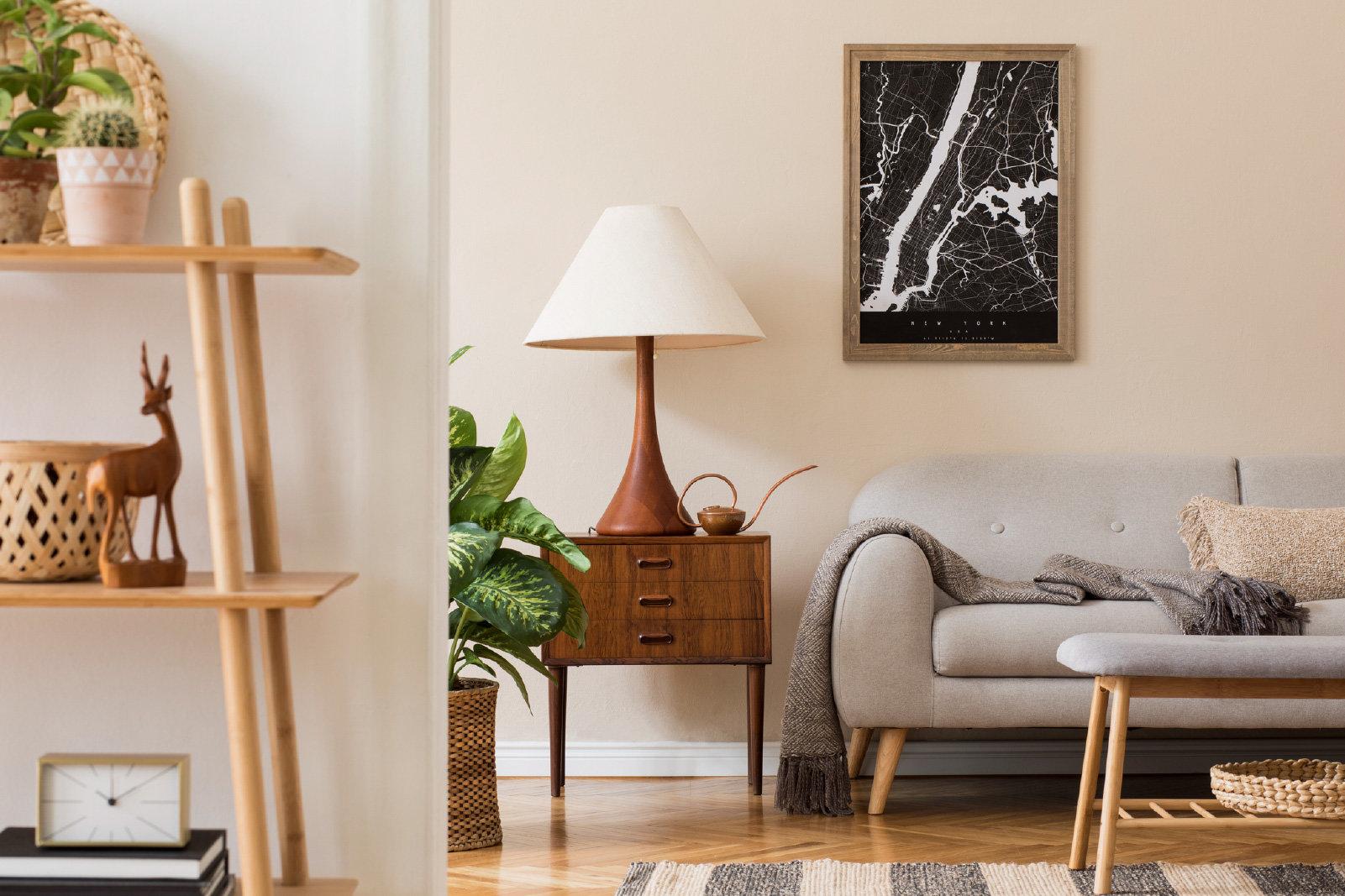Houses are flying off the market like hotcakes. But even in today’s seller’s market, staging a home can help you get the top dollar for your property in a fraction of the time.
Staging is about showcasing your home's best features with updated, neutral décor and colors (think Chip and Joanna Gaines). Buyers may be more committed to and willing to increase their offer by designing an engaging, move-in-ready atmosphere — often above the asking price.
If you’re preparing to sell your home, we’ve gathered home staging statistics from buyers’ and sellers’ perspectives to help you decide whether it’s the right move.
Home Staging Statistics: Buyer’s Perspective
When staging your home, bright red paint and bean bag chairs probably aren’t a great idea. Before beginning the hunt for a house, buyers scouring home design trends on Instagram and Pinterest will have expectations of how their future home should look. Instead of showcasing your personality, consider how you can help buyers envision themselves living in your home.
Let’s look at how home staging can influence a buyer’s decision in 2023.
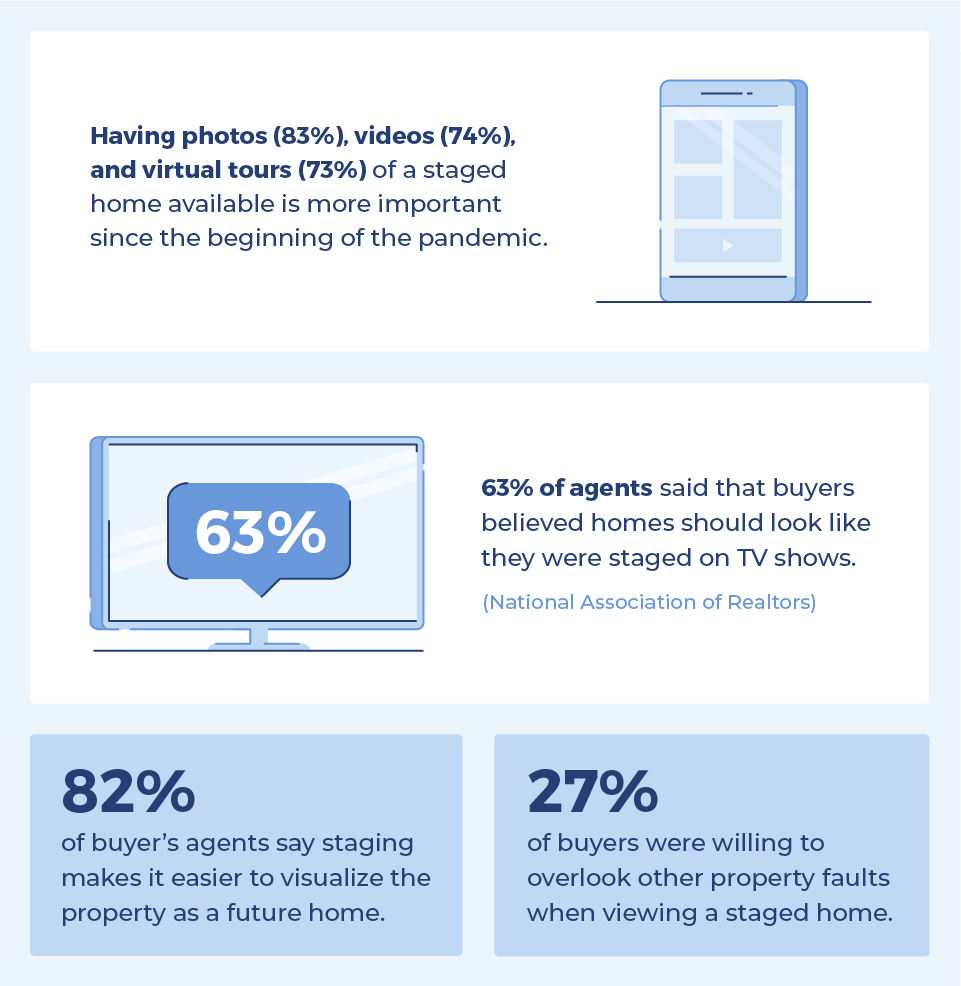
-
Before starting the buying process, 81% of respondents said that buyers had an idea about where they wanted to live and 76% knew what they wanted in an ideal home. (NAR)
-
Among buyers’ agents, having photos (83%), videos (74%), and virtual tours (73%) of a staged home available for their listings was more important since the beginning of the COVID-19 pandemic. (NAR)
-
41% of buyers were more willing to walk through a home they saw online. (NAR)
-
82% of buyers’ agents said staging a home made it easier for a buyer to visualize the property as a future home. (NAR)
-
97% of buyers’ agents say staging affects the buyer’s view of the home. (NAR)
-
Buyers linger in staged homes an average of 40 minutes — compared to just six minutes in a vacant home. (NAR)
-
63% of agents said that buyers believed homes should look like they were staged on TV shows. (NAR)
-
68% of agents said that buyers were disappointed by how homes looked compared to homes they saw on TV shows. (NAR)
-
39% of buyers’ agents claimed staging positively impacts the home value if it is decorated to a buyer’s taste. (NAR)
-
27% of buyers were more willing to overlook other property faults when viewing a staged home. (NAR)
-
23% of buyer’s agents said that staging a home increased the dollar value offered between one and five percent, compared to similar unstaged homes on the market. (NAR)
-
31% of buyers’ agents said that staging was equally important, and 31% said that staging was less important since the beginning of the COVID-19 pandemic. (NAR)
Home Staging Statistics: Sellers’ Perspective
Staging doesn’t just benefit the buyer — it can significantly decrease your home's time on the market and increase how much money you walk away with. However, the impact home staging makes will depend on the type of house and where it’s located.
Wondering if staging your home is worth the investment? We collected statistics from the seller’s side of the process to paint a clearer picture, including the percentage of staged homes and which homes experienced the greatest return on investment (ROI).
-
31% of sellers’ agents said they staged all sellers’ homes prior to listing them for sale. (NAR)
-
13% of sellers’ agents claimed they only staged homes they thought would be difficult to sell. (NAR)
-
42% of sellers’ agents stated that they did not stage homes before listing them for sale but suggested that the seller declutter or fix property faults. (NAR)
-
22% of properties bought and sold in the United States in 2021 were staged. (IAHSP)
-
The majority of staged homes (27%) were between $500-750K, followed by homes lists between $350-500K (25%) and $750-900K (21%) in 2021. (IAHSP)
-
Only 5.3% of properties between $100-350K had staging in 2021. (IAHSP)
-
When staging a home, 23% of sellers’ agents reported an increase of one to five percent of the dollar value buyers offered, in comparison to similar homes. (NAR)
-
18% of sellers’ agents stated that staging a home increased the dollar value of the home between 6 and 10%. (NAR)
-
In a 2021 survey of 4,600 staged properties, 73% sold over list price. (RESA)
-
31% of sellers’ agents reported that staging a home greatly decreased the amount of time the home was on the market. (NAR)
-
90% of homes staged before going on the market sell in 90% less time. (RESA)
-
83 days is the average days on the market (DOM) for a median-priced home before staging; after the home is staged, the average DOM is 7. (IAHSP)
-
In a 2021 survey of 4,600 properties, homes that were staged sold approximately 9 days faster than the average DOM. (RESA)
-
Median-priced homes that are staged prior to being listed only spend an average of 5 days on the market. (IAHSP)
-
Average houses that are staged sell 5–11 times faster than those that are not staged. (IAHSP)
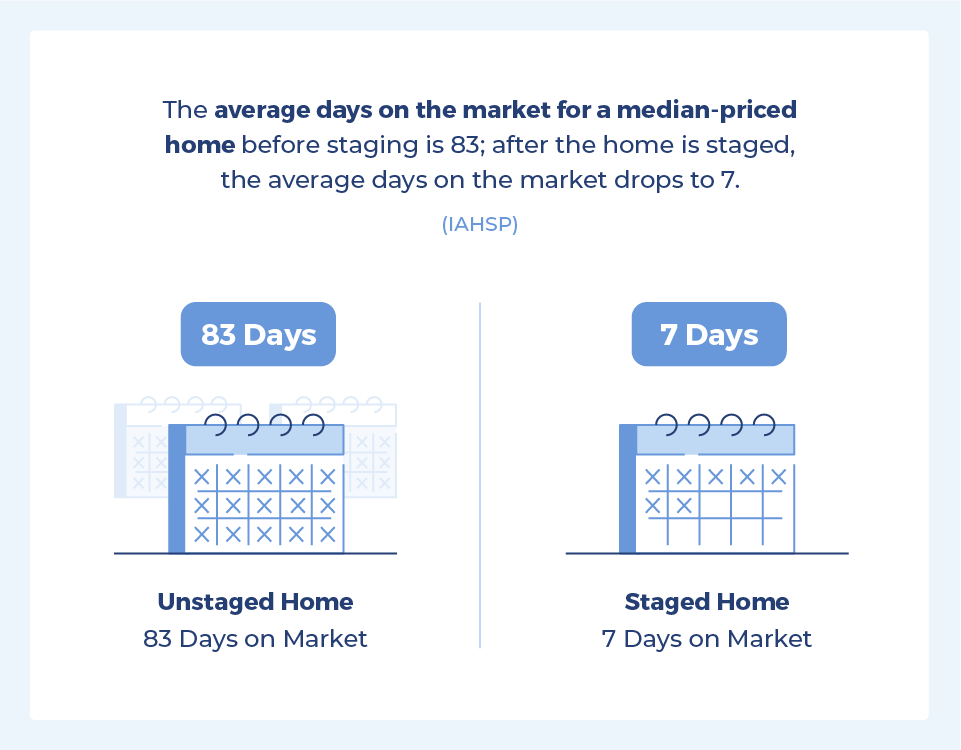
Home Staging Cost Statistics
So, how much can you expect to spend on home staging? It’s essential to research what staging services charge in your area and if you can use any of your existing furniture. Some sellers’ agents even offer their own staging services — sometimes complementary.
Let’s discuss the average price of staging a home based on who’s offering the service and the type of home being staged.
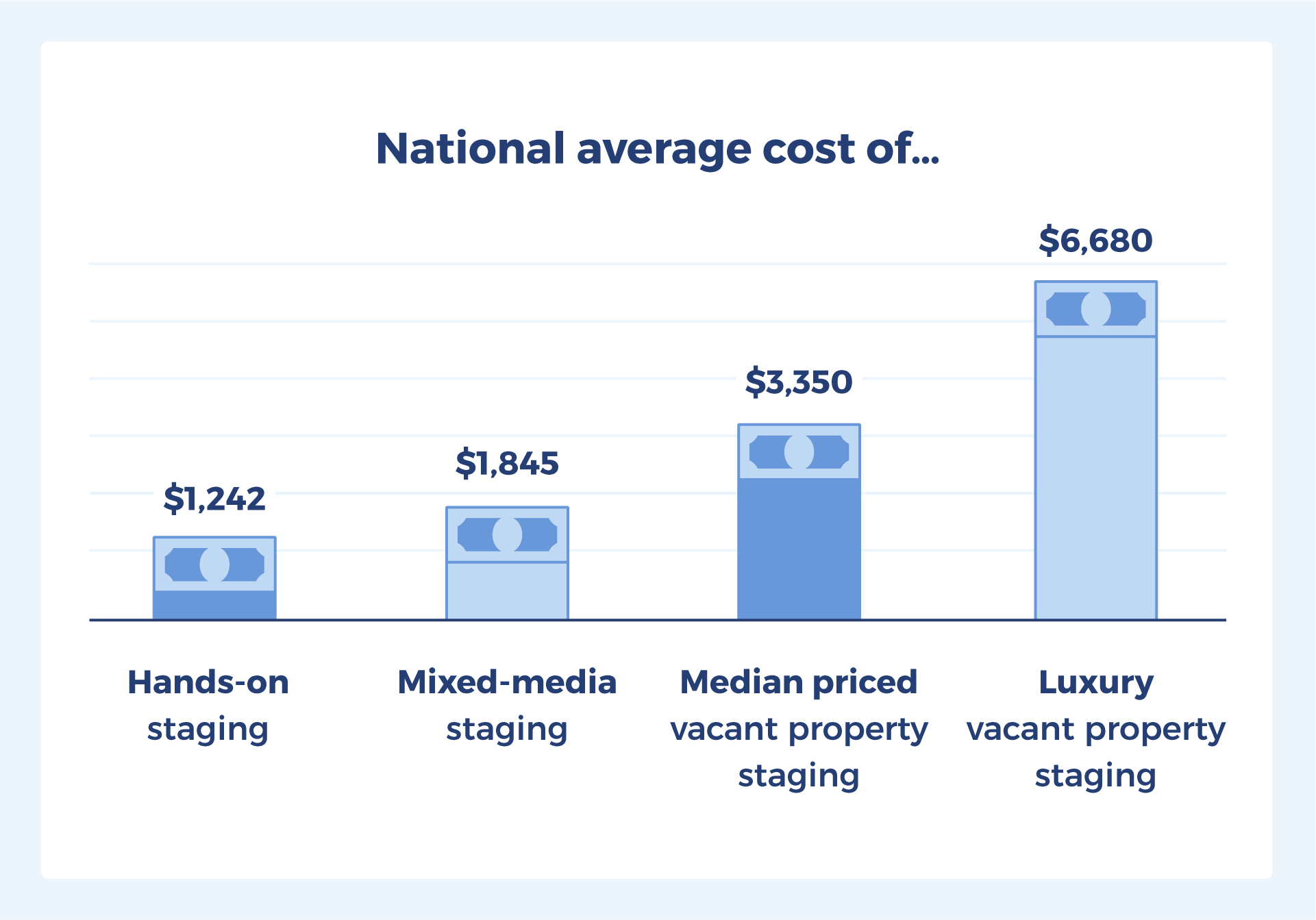
-
49% of sellers’ agents used a staging service. Agents also personally offered to stage the home (26%), and said that paying for staging was dependent on the situation (26%). (NAR)
-
The average staging investment of 1.3% resulted in a 7.1% over-list ROI. (RESA)
-
The median dollar value spent when using a staging service was $1,500, compared to $300 when the sellers’ agent personally staged the home. (NAR)
-
Home sellers typically pay between $749-2,820 in home staging costs. (HomeAdvisor)
-
Staging consultations range from $150-600. (HomeAdvisor)
-
Based on a 30-day term loan for staging items, pricing for staging a median-priced home ranges from $1,000-6,000+, depending on where the home is located. (IAHSP)
-
The average staging investment of 1.3% resulted in a 7.1% over-list return on investment. (RESA)
-
$3,350 is the national average for staging a median-priced vacant property. (IAHSP)
-
$6,680 is the national average for staging a luxury vacant property. (IAHSP)
-
$1,242 is the national average for hands-on staging using the homeowner’s personal belongings. (IAHSP)
-
$1,845 is the national average for mixed-media staging. (IAHSP)
Benefits of Home Staging
While the extent of the benefits of home staging will depend on your home and location, presenting a stylish, clean environment certainly doesn’t hurt your chances of selling your house.
If you need more convincing, read on to learn how past sellers have reaped the benefits after staging their properties.
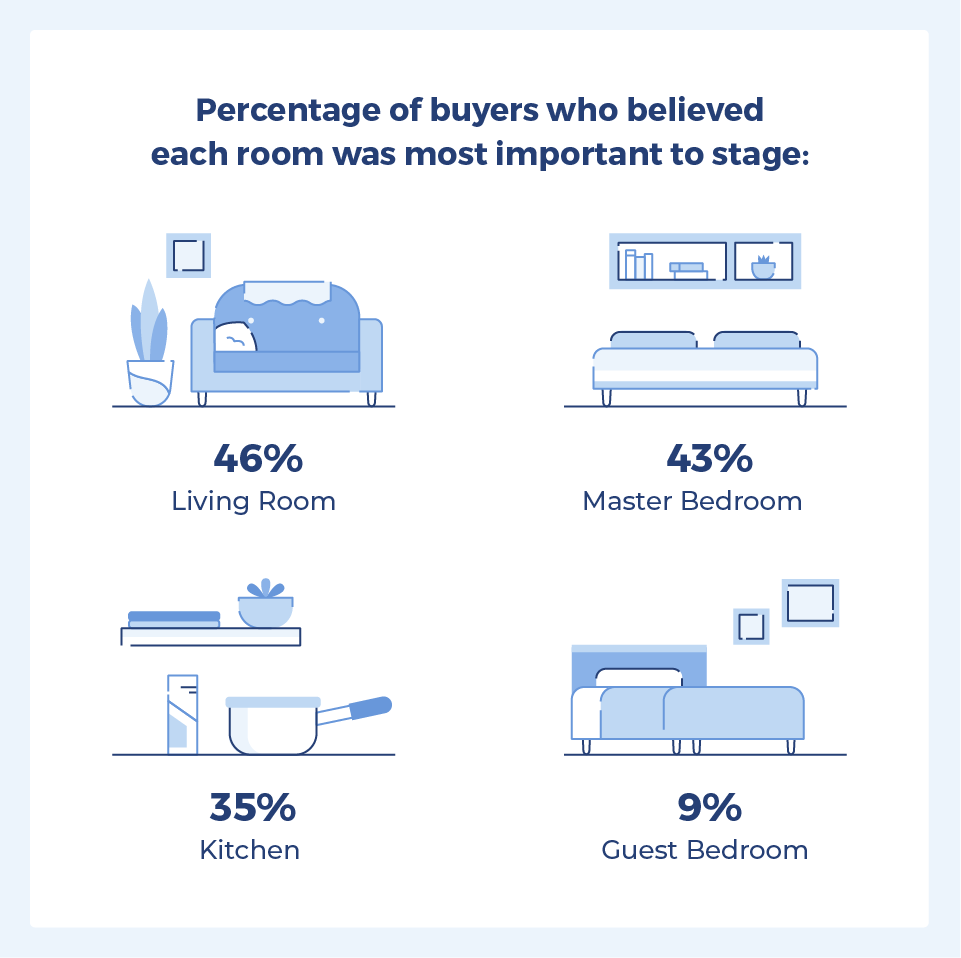
-
Staged homes sold on average $40K over list price. (RESA)
-
Staged homes on the market sold for 25% more than homes without staging. (Realtor Magazine)
-
50% of staged properties sold for 6% or more over list price, with nearly 10% selling 15-20% over list price. (IAHSP)
-
586% is the average ROI for staged vacant homes — and all sellers see an average return of 5-15%. (Bankrate)
-
Staging helps homes sell 5-11 times faster. (IAHSP)
-
In a 2021 survey, staged homes sold approximately 9 days faster than the average DOM. (RESA)
-
Staged homes spend between 33-50% less time on the market. (HomeAdvisor)
-
46% of buyers said staging the living room was most important, followed by staging the master bedroom (43%) and the kitchen (35%). (NAR)
-
Buyers’ agents cited staging the guest bedroom as the least important room, with just 9% saying that it was very important to stage. (NAR)
-
39% of sellers’ agents staged a home office or office space. (NAR)
-
The least common room to stage was children’s bedrooms, at 22%. (NAR)
-
The most common home improvement items agents recommended to sellers were decluttering the home (93%), entire home cleaning (85%), removing pets during showings (81%), and improving curb appeal (78%). (NAR)
Home Staging FAQs
Need a quick breakdown on whether staging your home is the right move to make? We’ve answered a few of the most frequently asked home staging questions based on the statistics above.
Does staging a home increase sales price?
Staging a home can increase the sales price. In fact, Staged homes on the market sold for 25% more than homes without staging, with half of those properties selling for 6% or more over the asking price.
Does a staged house sell faster than an empty house?
Staged homes have been shown to sell 5-11 times faster than vacant homes that are left unstaged. Median-priced homes that were staged prior to being listed only spent an average of 5 days on the market.
What percentage of sellers' agents stage their homes before listing?
According to the National Association of Realtors, 31% of sellers’ agents said they staged all sellers’ homes prior to listing them for sale.
How much does it cost to stage a house?
The median dollar value when using a staging service was $1,500, compared to $300 when the sellers’ agent personally staged the home. Only 30% of sellers spent more than $1,000 on home staging costs in 2021. If you follow budget-friendly home staging tips, the process can be affordable.
If you’re planning on selling your home in Raleigh, connect with our experienced real estate team to discover more ways to get the most out your home.
